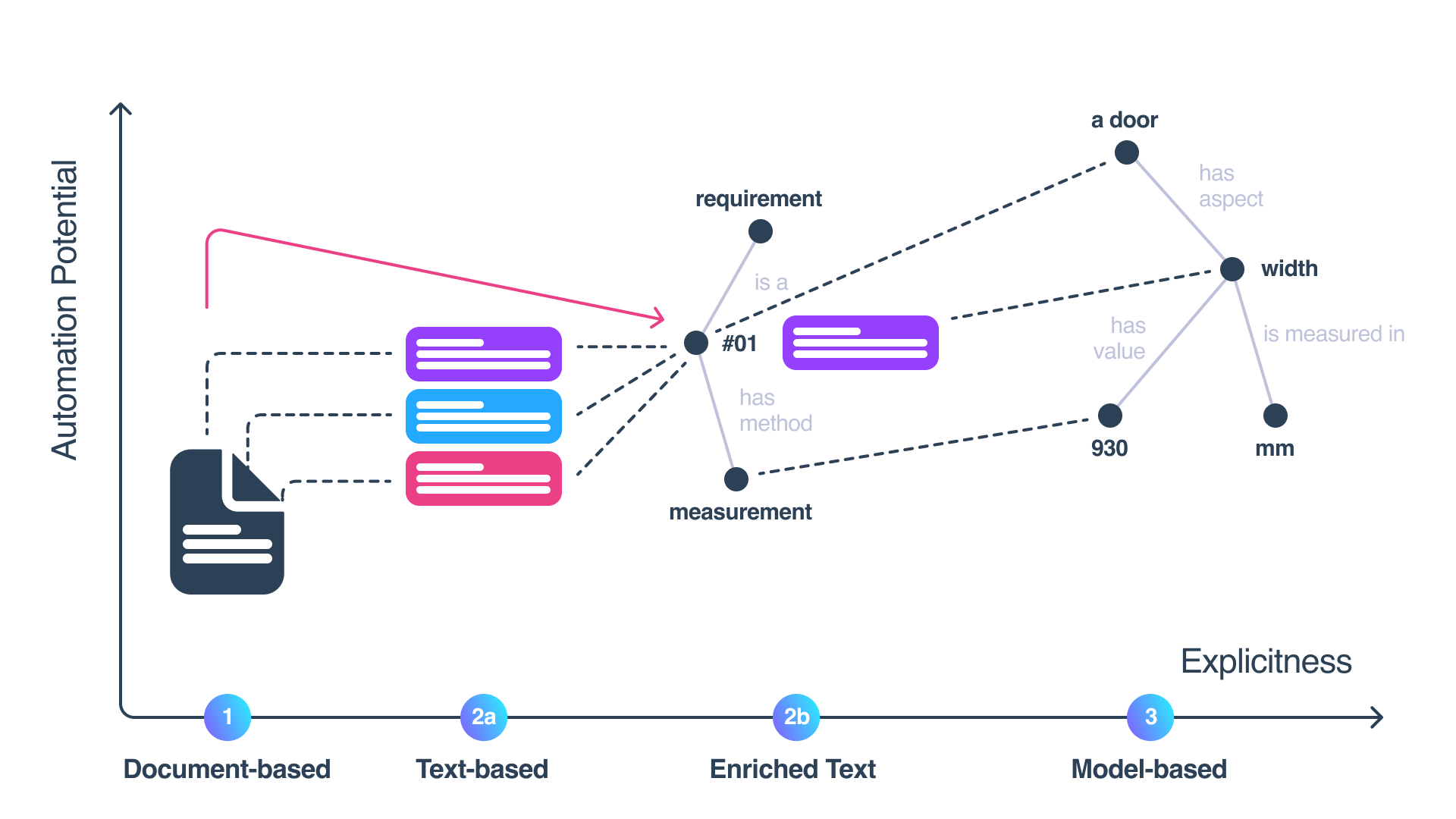From Spreadsheets to Smart Requirements: A Model-Based Approach
- Insight
In Requirements Management, professionals across various industries often face the challenge of dealing with time-consuming, repetitive tasks. These tasks typically involve scanning PDFs for requirements, updating spreadsheets, and reformatting information to fit into requirements management applications. This process is prevalent in infrastructure, energy, aerospace, and manufacturing sectors, where complex specifications are the norm.
The Shift from Document-Based to Model-Based Specifications
Traditionally, organizations have relied on document-based requirements stored in Word files, PDFs, or spreadsheets. While this method offers flexibility, it leads to inconsistencies, outdated information, and inefficiencies. Machines struggle to process text directly, necessitating human intervention to extract and convert text for validation or integration. We previously discussed why text-based and document-based requirements fall short in modern workflows; you can read more about it here.
A smarter approach involves transitioning to model-based specifications structured for human and machine readability. This shift reduces manual effort, improves consistency, and enhances automation. Organizations can store, retrieve, and integrate requirements with other applications by building a structured digital library of specifications, ensuring uniformity across projects.
Levels of Structuring Requirements
To better understand the shift towards model-based specifications, it is important to recognize the different levels of structuring requirements. We can categorize requirements into four levels based on their structure and automation potential. As we move from document-based to model-based approaches, the specifications become clearer, more reliable, and easier for both humans and machines to process.
- Document-Based: The most common approach, where they are stored in easily readable formats for humans but are prone to misinterpretation and inefficiencies.
- Text-Based Requirements: Structured and stored as individual text entities in databases, reducing duplications but losing important context from document structures.
- Enriched Text-Based Requirements: Adds real structure by linking requirements to objects, activities, and standards, improving machine processing while maintaining human readability.
- Model-Based Requirements: The pinnacle of automation, where requirements are fully structured and machine-readable, eliminating the need for human interpretation.

Image 1: Levels of structuring requirements
Overcoming the Pitfalls of Document-Based Requirements
When organizations rely on document-based requirements, they often encounter hidden inefficiencies that impact productivity and scalability. To avoid setbacks, it’s helpful to keep an eye on the following pitfalls:
- Searchability: Without structure, searching for specific requirements across multiple documents becomes complex and time-consuming.
- Actionability: Requirements stored in documents are not actionable, making it difficult to systematically create a coherent set of requirements.
- Static Nature: Plain text requirements do not integrate easily with software tools, leading to manual copying and pasting.
- Reusability: Without a structured system, reusing requirements across projects is challenging, limiting the ability to build on existing knowledge.
Implementing a Model-Based Approach
The solution to avoid setbacks and pitfalls of documents? Implementing a model-based approach. However, your requirements must be structured to be truly smart and support a seamless transition. Shifting from static text to actionable data is straightforward. Especially with the right tools. The Laces Standards Manager supports this transformation, guiding you through each step:
- Extracting Specifications: Convert unstructured text into structured model elements using manual methods or natural language processing (NLP).
- Enriching Specifications: Add attributes and metadata to make specifications more precise and informative, linking them to related elements like physical objects and activities.
- Publishing Specifications: Ensure interoperability by publishing specifications in open, machine-readable formats, following linked data standards and semantic web technologies.
Real-Life Use Cases
Smart, actionable requirements have many benefits that can be applicable in different scenarios. To better understand, we’ve highlighted three of the most significant use cases our clients deal with daily.
- Reusing Specifications: Organizations can eliminate inefficient extraction methods by creating a specification library, which ensures consistency across projects and allows integration with various tools.
- Defining Projects: By linking specifications to activity types and object structures, teams can quickly define project scopes and generate detailed requirements, improving project definition and reusability.
- Open Standards: Ensuring data flows easily between systems and stakeholders and linked data structures specifications for seamless sharing and compliance verification across different tools.
Conclusion
In conclusion, transitioning to a model-based approach in requirements management enhances efficiency, reduces manual work, and transforms requirements into a scalable asset. This approach supports better collaboration, consistency, and reusability across projects, ultimately unlocking long-term value for organizations.
If you’d like to know more about this topic, you can watch the webinar we recently hosted on this topic. You can re-watch the webinar by clicking here. The webinar includes a demo of the Laces Standards Manager which can support this transition fully.
Structure, Link, and Reclaim Control Over Requirements
In today’s complex engineering landscape, clarity is non-negotiable whether you’re working on a new satellite platform, an electric vehicle, or a regional water system. The systems we build are more complex, integrated, and dependent on data than ever before. And yet, one of the most critical ingredients for success, the specification, is still too often […]
ReadWhy You Should Use Laces to Simplify Verification and Compliance
Verification plays a critical role in industries where precision, safety, and accountability are non-negotiable, whether you’re designing infrastructure, building vehicles, or manufacturing medical devices. Yet, for many teams, managing the verification process is still a complex, manual, and error-prone task. This is where the Laces Requirements Manager comes in. It simplifies the planning and execution […]
ReadExtracting Specifications from Documents: Manual vs. NLP-Based Extraction
Extracting, interpreting, and applying specifications from technical documents, like standards, contracts, or regulations, is often a necessary but painstaking part of project or product management. Traditionally, this has been done manually, but recent advances in Natural Language Processing (NLP) have opened up new, intelligent alternatives. In this blog, we’ll explore the differences between manual and […]
Read


